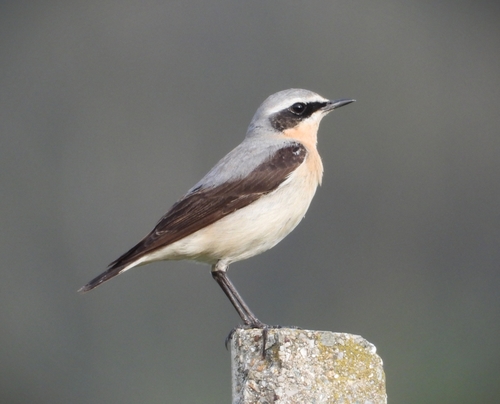
Northern Wheatear
The Northern Wheatear (Oenanthe oenanthe) is a small, migratory songbird known for its impressive long-distance migrations, one of the longest of any small bird. It breeds across a vast range, encompassing much of Eurasia and even extending into Alaska and northeastern Canada. This adaptable bird thrives in open, rocky habitats. Ecologically, it plays a role in insect control, consuming a variety of invertebrates. It is not currently considered globally threatened, but some populations face local declines due to habitat loss.
14.5-16 cm
Length
26-32 cm
Wingspan
Least Concern
Conservation Status
Distribution
Breeds across Europe, Asia, Alaska, and northeastern Canada. Winters in sub-Saharan Africa, with some populations migrating to South Asia. Its migratory routes span thousands of kilometers, often involving non-stop flights across oceans and deserts. Breeding altitudes range from sea level to high mountain slopes.
Lifespan
Typically 1-4 years in the wild, but can live up to 8 years.
Northern Wheatear's Habitat
Habitat Types
Tundra, Grasslands, Rocky outcrops, Heaths, Coastal dunes
Climate Zones
Arctic, Subarctic, Temperate, Boreal
Adaptations
Northern Wheatears are well-adapted to open habitats, with strong legs for hopping and running on the ground. They are also adapted for long-distance migration, with relatively long wings and the ability to store fat reserves for fuel.
Variations
Several subspecies are recognized, differing slightly in plumage and size. For example, *O. o. leucorhoa* (Greenland Wheatear) is larger and darker than nominate *O. o. oenanthe*.
Appearance
Breeding Plumage
Breeding males have a distinctive blue-gray back, black wings, black mask, and white supercilium. Females and non-breeding males are buffier and less contrasting. Non-breeding plumage is generally duller.
Seasonal Feather Changes
Plumage becomes brighter and more contrasting during the breeding season, particularly in males.
Sex Based Plumage Differences
Males have a bolder black mask and blue-gray back during breeding season, while females are browner overall.
Notable Features
Conspicuous white rump and black 'T' pattern on the tail (visible in flight), Upright posture when perched, Short, slender bill
Diet and Feeding
Primary Foods
Insects, Spiders, Other invertebrates, Berries (occasionally)
Foraging Behavior
Primarily forages on the ground, hopping or running to catch prey. Also makes short flights to catch flying insects. Often perches on rocks or low vegetation to scan for prey.
Specializations
None particularly specialized, but their agility and sharp eyesight aid in capturing a wide range of terrestrial invertebrates.
Seasonal Diet Variations
Diet shifts slightly depending on prey availability. Berries may be consumed more frequently in late summer and autumn before migration.
Behavior
Social Structure
Generally solitary or in pairs during the breeding season. May form small flocks during migration.
Communication
Chattering calls, A melodic song consisting of warbling and chattering phrases, Visual displays, such as wing and tail flicking
Migration
A long-distance migrant, with some populations undertaking remarkable journeys. The Alaskan population, for example, migrates across Asia to reach its wintering grounds in Africa, a journey of up to 14,600 km. They use a combination of celestial and magnetic cues for navigation.
Territorial or Group Behaviors
Males are territorial during the breeding season, defending their nesting area from rivals. Outside of breeding, they are less territorial.
Conservation
Threats
Habitat loss (due to agriculture and development), Climate change (affecting breeding and wintering habitats), Pesticide use (reducing insect prey)
Protection Programs
General habitat conservation measures
Local National Laws
Protected under various national bird protection laws, such as the Migratory Bird Treaty Act in the US and Canada.
Population Trend
Stable overall, but some regional declines have been noted.
Population Estimates
Global population estimated to be in the millions.
Interesting Facts
The Northern Wheatear has one of the largest ranges of any songbird.
Its breeding range spans multiple continents.
Some populations undertake one of the longest migrations of any small bird.
The Alaskan population's journey to Africa is particularly impressive.
The name 'wheatear' refers to the bird's white rump.
It's derived from the Old English words meaning 'white' and 'arse'.
Faqs about Northern Wheatear
Where can I see a Northern Wheatear?
Look for them in open, rocky habitats during the breeding season in their respective ranges (Europe, Asia, Alaska, and northeastern Canada). They are often seen perched on rocks or fences.
What do Northern Wheatears eat?
They primarily eat insects and other invertebrates, but also occasionally consume berries.
Are Northern Wheatears endangered?
No, they are classified as 'Least Concern' by the IUCN, but some local populations may be declining.
How do they find their way during the migration?
They use the sun, stars, and Earth's magnetic field to navigate.
Copyright @ Nature Style Limited. All Rights Reserved.
 English
English